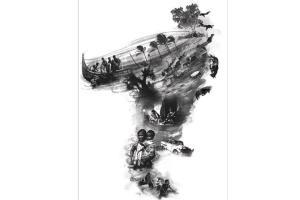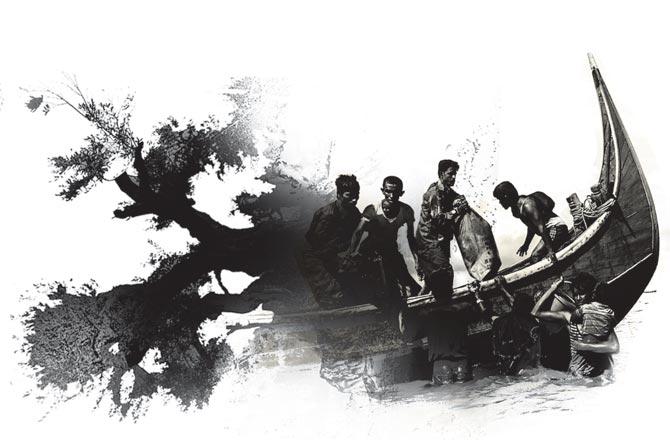Nisarga was nothing. The children of 1948, now the city's golden generation, relive vivid memories of the severe cyclone that battered Bombay that year

Digital Illustration\Uday Mohite
 It was a rather restless couple of days for several city seniors. Two weeks ago, everyone, from the Indian Meteorological Department and Skymet to news channels and national dailies, as well as eminences like author Amitav Ghosh, warned that a cyclone was hitting Bombay after a hundred years. Those who wondered and voiced otherwise—suggesting they witnessed terrible 1948 cyclone frenzy—heard younger family members scoff. "Could I be mistaken, why does nobody believe this?" many fretted at being doubted.
It was a rather restless couple of days for several city seniors. Two weeks ago, everyone, from the Indian Meteorological Department and Skymet to news channels and national dailies, as well as eminences like author Amitav Ghosh, warned that a cyclone was hitting Bombay after a hundred years. Those who wondered and voiced otherwise—suggesting they witnessed terrible 1948 cyclone frenzy—heard younger family members scoff. "Could I be mistaken, why does nobody believe this?" many fretted at being doubted.
Not Bhupen Dalal. Irate at "TV anchors trumpeting this came after 123 years and the Times not bothering to check their own archives", the septuagenarian wanted to set straight the record. Late at night he shot Ghosh a spirited email, starting, "I am surprised..."
ADVERTISEMENT
He was mollified by the within-an-hour response: "Dear Mr Dalal, you are right. I and my collaborator Dr Adam Sobel made an error. The measurement of cyclones differs in the US and India. Dr Sobel has since issued a correction. Best wishes. Amitav Ghosh."

Dalal's dissent elicited less grace locally. With no account detailing the earlier calamity even once confirmed, he rounded up some St Xavier's School classmates to recount experiences of that far worse cyclone. On November 22, 1948, Dalal was with his parents in Borivli. "It was just past my seventh birthday. Winds moved at great speed and rain pelted down dangerously heavy. There was only one street, Ghodbunder Road (SV Road). Strewn with dropped trees, it was available for us on one side alone."
Making landfall around Alibaug, Nisarga has tragically routed Raigad. Its precursor, however, devoured the city itself with ferocity. A communique issued by the Bombay Provincial Government estimated mounting casualties by drowning and at least 100 victims injured by collapsing debris. All India Radio's medium-wave transmission was wiped clean, short-wave sputtered on a generator. Fishing boats and motor launches sank, schools shut, and five damaged hydro-electric power lines disrupted transport modes, including trams whose overhead wires were affected.
"Shocking that the press coolly overlooked 1948," says Desmond Fernandes from Chuim village, Bandra. He distinctly remembers savage squall bursts fell mango trees lining the path where Pali Hill Hotel stands. "Tiles and stones of our semi-kuccha structures swirled unsafely. We sat with hands folded for the city." Prayerful amid pandemic, too, parishioners keep the faith, chanting evening rosaries around pebbled grottos, suitably apart, leaning from verandas.
The island city bore the brunt of the cyclone striking after sunset on November 21, 1948. In Art Deco apartments along Marine Drive children cowered, watching hungry tides leap. From Room No. 3 atop the Sea Green Hotel signboard, Vikram Rajaram saw images flash, which both fascinated and terrified him at age six. "My father, the Tata Mills' manager, decided to stay here to play daily tennis at CCI. That storm went wild. A cast iron pipe broke, denting our grey Citroen parked between the hotel and Brabourne Stadium. And, I can still visualise a stupid chap having the temerity to open his umbrella against such anger of the elements."
Premchandra Parekh saw Arabian Sea levels rise alarmingly, from Rupayatan building, renamed Al-Jabreya Court when Kuwaiti royals bought the plot as a holiday retreat. "At the time, none of our balconies had windows encasing rooms," he explains. "Wet pools streamed in, driven by unstoppable southwest winds. With smashed glass panes at our feet, I was taken back to the dock accident damage from the SS Fort Stikine explosion four years before, etched in my mind though I was three."
At 11, Freni Bilimoria, now Sidhva, woke up to mayhem outside P block in Cusrow Baug on Colaba Causeway. Tucked near the rear of the Parsi enclave (interestingly lettered A to U, skipping I, L, N and O) architect Claude Batley conceived in 1934, her home lay close to European barracks whose soldiers thrilled neighbourhood kids. "We would run to peepholes in the brick wall through which they slipped us foreign chocolates!" she recollects. Telltale whiffs of gales had gained momentum overnight. Bilimoria was stunned to hear banging loud as a bomb blast. The roof sheathing Wellington Mews horse stables had been caught in a scoop. Swooping off, it flew madly to crash-dive with a deafening clang in the colony courtyard.
Further south, seven-year-old Chiku Advani froze as howling winds circled his residence at Candy Castle. Filmmaker Pooh Sayani shares that this building, named for her youngest aunt, was among a Colaba trio her "Nanabapa", grandfather Jafferseth Padamsee, commissioned (with Chotu Terrace and Theatre Group adda Kulsum Terrace for his wife Kulsumbai). The sole surviving Padamsee of her generation, Candy was born Dilshad but rechristened by Miss Murphy, whose Altamont Road boarding school she and her siblings attended. The Irishwoman renamed Sultan as Bobby, Roshan was Rosh, Pooh's mother Zarina was Jerry, Shiraz was Bapsi or B, Roshanali was Alyque, Chotu was Cho, Aziz was Bubbles and Dilshad became Candy.
"With no authoritative meteorological caution, we were weather-vanes predicting climate," says Advani. "That trouble was brewing appeared evident from overcast skies, eerie clouds, dark seas badly battering rocks. No one gauged the severity of this lashing we'd be at the mercy of. Candy Castle proved safer naturally than the pier where high pressure winds twisted and changed direction. They tossed out deckchairs and other furniture of the Radio Club, blowing it at a crazy velocity to distant Juhu Beach. Apollo Bunder's really hefty, weighty paving was ripped and bashed around."
With front-paged headlines "Bombay paralysed by cyclone" and "City isolated from rest of country", The Times of India's November 23 edition snuck in a sentence whose inadvertent irony caught an observant friend's eye. The column describing rampant harbour havoc read: "A five-ton cruiser washed ashore at Ballard Bunder and 'Lot's Wife', a luxury yacht of the Salt Revenue Department, was located in shattered condition." A throwback to the episode of Lot's wife who was transformed into a salt pillar, that sailing vessel might have been baptised by an Englishman with trust in the Bible and a wry sense of humour.
Further south, fast swelling waters swallowed stretches of mangroves where the President Hotel is today. "It was incessant, an absolute mini tsunami," says Dina Daver, then Billimoria. An eight-year-old in the villa simply known as 21 Cuffe Parade, till it became Bagh-e-Abbas, she remembers, "The walkway to the sea, opposite Yuku Hamied's home (Indo Saracenic-Neo Gothic gem Jasim House, later Taraporevala Mansion, also the address of writer Mulk Raj Anand and his dancer wife Shirin Vajifdar)—where my sister and I walked with our grandfather—got wholly submerged. Tall palms swayed so low, we thought they were about to fall any minute. Our promenade was part of the sea and the road a flood. When the rain abated, people brought out little dinghies, rowing them to wherever."
Century-old trees found themselves brutally uprooted throughout town. Among them, sturdy specimens at Pedder Road, recalls structural engineer Shirish Patel, who in 1964 built our first flyover, the iconic one at Kemp's Corner, going on to envisage New Bombay with Charles Correa and Pravina Mehta. A teenager in the Carmichael Road bungalow the family occupied during his father's 1946-52 tenure as Bombay's first non-British Municipal Commissioner, Patel dismisses Nisarga's impact as "barest rain with scattered strong gusts soon fizzling out". He points out that Pedder Road was widened following the disaster.
More inward midtown, the relentless scene did leave Pravin Vakil of Bhuleshwar elated at the prospect of an unexpected short vacation from GT School. "With widespread destruction in the Panjrapole area where we were, CP Tank shops sold overpriced candles and had people pay R100-150 for each hurricane lamp. My uncle travelled to Dharavi for a dividend amount due to him from Western India Tanneries. The surge of flooding forced a 10 hour-long journey back on foot when trains ground to a screeching halt. He reached home with clothes in complete tatters, snagged while wading across road upon road piled with snapped tree branches that scratched him."
Besides memories of fending off sand that spilled through tightly louvered windows at her Prarthna Samaj home, Minakshi Desai, nee Rele, relates how the cyclone spoilt a charming weekend hobby. With four friends living on the same street, she used to gather "tandul mani" (rice beads) from Chowpatty. Their routine involved choosing grains with a hole, which they strung together in pretty necklaces, bangles and earrings. As murmurs of a possible storm approaching grew, their families obviously forbade the girls from indulging in that favourite pastime. "Instead of bead picking, we were dazed by the onslaught of the cyclone when it arrived," she says. "That was no ordinary layer of sand breezes blew till Opera House."
The Bombay Chronicle dated November 25 finally breathed a semblance of calm. The announcements "Bombay recovering steadily" and "Transport almost restored to normal" were received with tremendous relief. Not, of course, without seriously rattling citizens. As Freni Sidhva says, "November 1948 left us very shaken, very afraid. What happened last fortnight was nothing."
Author-publisher Meher Marfatia writes fortnightly on everything that makes her love Mumbai and adore Bombay. You can reach her at mehermarfatia@gmail.com/
www.meher marfatia.com
Catch up on all the latest Mumbai news, crime news, current affairs, and a complete guide from food to things to do and events across Mumbai. Also download the new mid-day Android and iOS apps to get latest updates.
Mid-Day is now on Telegram. Click here to join our channel (@middayinfomedialtd) and stay updated with the latest news
 Subscribe today by clicking the link and stay updated with the latest news!" Click here!
Subscribe today by clicking the link and stay updated with the latest news!" Click here!







